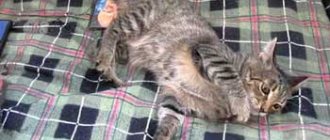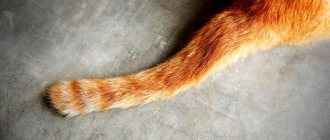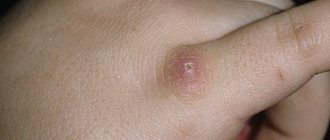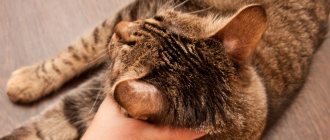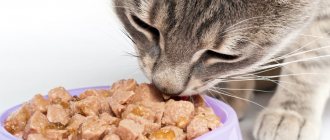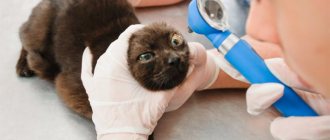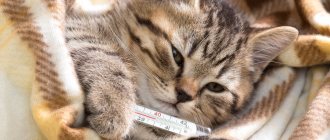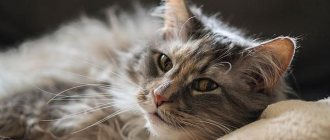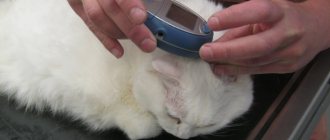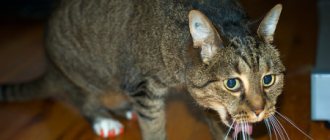Diabetes mellitus in cats is one of the most common diseases of the hormonal system, which is based on a violation of carbohydrate metabolism. The pathology mainly occurs in older animals, more often in neutered cats than in cats. In this article we will talk about why diabetes occurs in cats, why it is dangerous, and how to treat it.
Definition of disease
Diabetes mellitus belongs to the group of endocrine diseases. One of the characteristic symptoms of this disease is unquenchable thirst and frequent urination, resulting in dehydration. There is an increased sugar content in the blood and urine.
This condition threatens the animal's life. In diabetes, the pancreas produces little or no insulin. Glucose and sugar entering the body are not broken down; they enter the blood unchanged and then enter the urine. As a result, metabolic processes throughout the body are disrupted.
Insulin is a protein. Its main function is the breakdown of glucose. It is not produced by the entire pancreas, but by its beta cells. They are located among the gland tissues on the so-called islets of Langerhans.
Beta cells die for various reasons. When their number decreases catastrophically, insulin will cease to be produced. The development of diabetes mellitus is an inevitable consequence of these disorders.
Why are glucose and insulin needed?
Glucose is absorbed into the blood from the intestines and then enters cells throughout the body. Insulin is needed for glucose to enter cells.
Glucose is a type of sugar. It is formed when the body breaks down nutrients. Glucose is a source of energy for organs and cells of the body.
Insulin is produced by the pancreas. This hormone is responsible for ensuring that glucose enters cells and organs. Insulin is like a key that opens a channel in cells for glucose to enter.
Insulin tells cells to take up glucose
Types of diabetes in cats
There are 3 types of diabetes in cats. In humans, the disease is chronic and incurable; only correction of the condition and supportive therapy are possible. In cats, the situation is not so sad - the second and third types are curable with adequate treatment or elimination of the cause of the disease.
First
This type of diabetes mellitus is rarely diagnosed in cats. The animal's pancreas does not produce insulin on its own due to the death of all beta cells, so its absolute deficiency develops. If the cat is not provided with insulin replacement therapy, the development of ketoacidosis is inevitable. The next stage is coma.
Second
In cats with type 2 diabetes mellitus, insulin is produced in sufficient quantities. However, tissues and organs do not respond to it. The cause of this pathology is often age-related changes - older cats are usually affected. Another risk factor is obesity.
Type 2 diabetes is the most common - it is diagnosed in 90% of cases.
Third
Type 3 diabetes is called secondary or acquired. Usually its appearance is associated with pathologies of the cat’s pancreas, which arise:
- while taking medications;
- as a consequence of genetic diseases;
- due to metabolic disorders.
This is the mildest form of diabetes in cats. After the underlying disease is cured, the sugar disease will subside.
How is therapy carried out?
When diabetes mellitus is detected in cats, treatment can be quite long and is usually combined. Therapy involves eliminating the factors and symptoms causing the disorder. A prerequisite is the normalization of the animal’s body weight. For this purpose, special dietary foods and a low-carbohydrate diet are used, and insulin-containing medications can also be used.
First aid rules
When a cat is prescribed insulin, it must be injected on a set schedule. Delaying even one injection will disrupt the schedule, which may result in hypoglycemia (excess insulin). The sugar concentration will drop to critical levels, and the cat will show symptoms:
- weakness;
- apathy;
- impaired coordination;
- convulsions;
- coma.
The main thing is to prevent a state of coma, since cats rarely return from it. If you notice these symptoms, it is important to check your sugar levels. If it is critically small, give the animal food with fast carbohydrates. If your cat refuses to eat on his own, pour sugar syrup into his mouth or soak gauze in it and wipe his gums. If the animal does fall into a coma, you should not give it anything to prevent it from choking. It is important to take your cat to the clinic urgently.
Basic therapy
Treatment of cats with diabetes is selected taking into account the form of the disease. If it is the first type, short-acting insulin injections will be needed, and with the second type, instead of hormonal injections, drugs to lower sugar levels or injections of medium or long-term action are required.
- Drugs to reduce sugar. These are mainly tablets prescribed for types 2 and 3 diabetes. The medicine reduces the concentration of sugar to normal levels and eliminates the adverse effects of sugar on all systems and organs. The general condition of the animal is rapidly improving. All medications should be given only as prescribed by a veterinarian, as many have side effects.
- Hormonal injections. The difficulty with using insulin is that it is always difficult to choose a dosage that will help effectively treat the disease. This requires regular glucose monitoring after each new dose. Accordingly, studies are carried out in stationary conditions. The doctor records the time, calculates the dosage and determines the duration of action of insulin injections. Taking into account these data, a scheme for the use of insulin is formed in each individual case.
- Correct diet. Normal nutrition for diabetes involves following a diet. A veterinarian should tell you what to feed a cat with diabetes. The main thing is that it is based on animal proteins. At the same time, the volume of carbohydrates is minimized. It is also important to find food without potatoes, cereals, sweeteners and sugar. Meals should be multiple - 5-6 times a day, and always in small portions.
How common is the disease?
No one has conducted studies on the incidence of diabetes mellitus among cats, so there are no official statistics on this issue.
However, it is safe to say that the number of sick animals is steadily growing. This is due to an increase in the number of pet cats that are overweight or obese.
Diabetes mellitus ranks first among endocrine diseases in terms of incidence. Anecdotal evidence suggests that one in 400 domestic cats is diagnosed with diabetes.
Often owners feed their pets and do not care about their physical activity. They are touched by a plump kitten; they do not think about the fact that by the age of 5–6 years he will acquire the status of a diabetic.
Important! In small breed cats, exceeding the standard weight by more than 1.5 kg is considered obese. They will not be allowed to do breeding work, and they will fall into a health risk group.
With age, the likelihood of developing diabetes increases significantly. It is important to pay increased attention to older pets so as not to miss the opportunity to correct their health condition.
The mechanism of pathology development
In a healthy body, glucose is broken down by insulin, converted into energy and nourishes cells. If there is a lack of insulin or immunity to it, glucose does not reach the cells - they starve. As a result, intracellular processes either slow down or stop.
Excess glucose causes the blood to thicken. The cells are instructed to release moisture into the blood to facilitate blood flow. Organ tissues become dehydrated. In order to restore the water balance, a lot of water is needed - the animal becomes thirsty.
The body tries to get rid of excess glucose in the blood and sends it to the kidneys for filtration. “Scared” by a huge amount of sugar, the kidneys are knocked out of the correct mode of operation. The result is increased urination.
If cells do not receive the energy that is generated by the breakdown of glucose, they begin to starve and become exhausted. To prevent the death of the body, the brain switches to “emergency mode”: it commands the cells to break down fat reserves. As a result of the breakdown of fats, ketone bodies enter the blood. This is a by-product of the metabolic process, in other words, poison.
If your cat smells of acetone, the process of ketosis has begun - the formation of ketone bodies. This condition can be corrected with medication and diet. But if measures are not taken in time, ketone bodies will gradually poison the blood and lead to ketoacidosis. Then comes coma and death
Ensuring your cat's well-being
For most cats, stabilization can be achieved very easily with lifelong therapy and related measures. You should work with your veterinarian to determine the best insulin dose, ideal diet, and lifestyle adjustments (if necessary) to achieve maximum control. Make sure you give your cat the correct dose of insulin on schedule. Maintain a regular feeding schedule and offer your pet the amount of food recommended by your veterinarian. Do not give your cat medications, including vitamins or nutritional supplements, without first consulting your veterinarian.
Causes of the disease
Predisposition to diabetes mellitus in cats may be congenital. There are 9 more factors that influence the development of the disease:
- Imbalanced diet. A loving owner wants to pamper his pet and gives him “goodies” from his table. The presence of fatty, spicy, fried, smoked and sweet foods in a cat’s menu leads to overload of the digestive system. The animal's body is not able to cope with such food. This leads to disruption of metabolic processes. The situation is aggravated by non-compliance with the feeding regime.
- Uncontrolled eating will definitely lead to obesity. The cat’s liver and pancreas are forced to constantly work in “emergency” mode. Failures in the functioning of these important organs are inevitable, this serves as an impetus for the development of diabetes mellitus.
- Heart diseases. There are hypertensive cats among cats. The consequence of high blood pressure is disruption of the functioning of many organs. As a result, their sensitivity to insulin decreases.
- Viral diseases. Frequent infections reduce immunity and negatively affect the functioning of internal organs. The pancreas also suffers.
- Acute and chronic pathologies of the gastrointestinal tract. Colitis, ulcers, enteritis, gastritis, pancreatitis can cause the development of diabetes mellitus in cats.
- Congenital pathologies of the pancreas, kidneys, liver, heart.
- Taking diuretics and hormonal drugs to control sexual behavior.
- Stress. Moving, renovations, and frequent visits to pet hotels are good reasons for cat distress. Against the background of a stressful state, eating behavior changes: the cat may refuse food or, conversely, will begin to “eat up” fear. The result is a metabolic disorder, which increases the cat’s chances of acquiring diabetes.
- Lack of physical activity is one of the main factors. Almost all domestic cats exercise little and, as a result, gain excess weight. The animal develops obesity.
Important! Diabetics are most common among castrated and sterilized cats. Males suffer from this disease more often.
Symptoms
Signs that should alert cat owners:
- excessive thirst;
- excessive urination (increased frequency and amount of urine);
- increased appetite or lack thereof;
- dull, sloppy coat;
- tachycardia;
- weight loss.
These are classic signs of diabetes in a cat, so don't hesitate to visit your veterinarian if you notice changes in your pet's condition.
When the condition is neglected, the animal develops wasting of the back muscles, weakness in the hind legs, lethargy, jaundice, convulsions, fainting, the smell of acetone from the mouth, and vomiting.
The cause of the disease can be dry food and Whiskas, so read how to wean your cat off dry food.
Symptoms of diabetes in cats
Depending on the type of diabetes mellitus, the symptoms and clinical picture of the disease look different.
Type 1 diabetes in cats is characterized by increased thirst. Due to insulin deficiency, unbroken sugar enters the blood. The animal's excretory system is not able to process it. The kidneys work harder, resulting in frequent urination.
The cat is thirsty and drinks a lot of water. It turns out to be a vicious circle. Owners may miss the initial manifestations of the disease, since urination does not cause pain to the animal.
Important! If a cat begins to urinate outside the litter box, this is an alarming sign for the owner. It happens that the animal does not have time to wake up in time and partially empties its bladder in its sleep on the bedding.
There may be changes in appetite, the cat's weight increases or decreases greatly. The fur becomes dull and the sick animal sheds constantly. As diabetes develops, digestive system disorders occur - vomiting and diarrhea are possible.
Rapid heartbeat is also a symptom. The cat becomes apathetic and lethargic. At the stage of intoxication of the body, the smell of acetone will appear. This is a sign of liver damage. Convulsions and fainting will complement the list of clinical manifestations.
Animals with type 2 diabetes begin to gain weight sharply. Thirst and frequent urination are noted. The smell of acetone is not noticeable, the appearance of the cat at the beginning of the disease remains the same. As the disease progresses, the quality of vision decreases and lethargy appears. Body itching bothers me. The cat may scratch itself until sores appear.
Type 3 diabetes mellitus is acquired. Its development is directly related to the underlying disease that caused it. As soon as it is eliminated, the sugar disease will go away.
Diagnosis of the disease
Only a veterinarian can make a correct diagnosis of a cat. The symptoms of diabetes in cats and humans are similar, but the treatment methods are different. Only a qualified doctor can prescribe a diet, medications and their dosage.
Typically, an animal does not arrive at a medical facility at the initial stages of the disease. The symptoms are pronounced, but they are also characteristic of many other diseases. Therefore, it is often necessary to carry out differential diagnosis to exclude or confirm concomitant diseases.
When conducting DD, the gastrointestinal tract, liver, and cardiovascular system are examined. Eliminate the presence of parasites and infections.
During a clinical examination, the doctor notes the main symptoms of diabetes mellitus, common to all three types:
- poor condition of the coat;
- exhaustion or obesity;
- change in gait;
- dehydration;
- decrease in body temperature.
Next, the cat’s blood is examined according to the following parameters:
- for sugar content;
- for biochemistry;
- general analysis;
- on thyroid hormones;
A urine sample is required to test for sugar content. The accuracy of the diagnosis will be confirmed by an ultrasound of the abdominal organs.
Treatment of diabetes mellitus in cats
Based on the results of tests and examinations, the doctor determines the type of disease and prescribes appropriate treatment. It is necessary to understand that treating diabetes mellitus is a long process. The owner of the animal will need strength, patience, and accuracy.
Treatment is aimed at eliminating either the symptoms of the pathology or the factors that provoked its occurrence.
Insulin therapy
Chronic insulin therapy is necessary for cats with type 1 diabetes. A special drug is produced for them - it differs from the one used to treat people. Insulin therapy is prescribed to the animal depending on the severity of the disease and the phase of the disease. The dosage and dosage regimen is determined by the attending physician individually.
Cat insulin has a short duration of action, so injections will have to be given 2-3 times a day. The injection is placed in the withers with a thin and short needle, so the cat hardly feels pain.
It is strictly not recommended to independently diagnose and treat a cat with insulin. Treatment at home without a doctor's advice will lead to the death of the animal.
If during the initial appointment the doctor suggests leaving the cat in the hospital, you should not refuse. Within 24 hours, the optimal dose of medication for effective treatment will be selected for her. The next day the pet is returned to the owner with precisely verified recommendations.
Diet therapy
Insulin therapy must be combined with diet. For treatment to be successful, the cat’s weight must be brought back to normal. The change in mass should be smooth and gradual.
A clear diet is established. To avoid sudden fluctuations in glucose levels, you should feed your sick cat small meals up to 6 times a day.
Easily digestible carbohydrates are completely excluded from the diet of a diabetic cat. The menu includes protein foods and fiber. Your cat's diet should not include:
- legumes (soybeans, peas, beans);
- flour products;
- porridge - rice, corn, semolina, millet.
Up to 50% of the diet consists of meat and offal, fish, and poultry. They can be given raw, after defrosting. Up to 25–30% comes from lactic acid products – low-fat sour cream and cottage cheese. From 20 to 25% are boiled vegetables.
Specialty stores offer a wide selection of food for diabetic cats. The best premium and holistic medicinal foods:
- Purina Veterinary Diets - normalizes metabolic processes and provides complete nutrition to a sick animal.
- Royal Canin Diabetic - with a high protein content, it contains cereals with a low glycemic index.
The cat owner should understand that a diet is not a temporary measure, but a new way of life for the pet. The basic principles must be followed for life.
Cats at risk for diabetes should not be fed Whiskas brand products - they contain a high amount of carbohydrates.
The prognosis for the results of diabetes treatment is directly dependent on the severity of the cat’s condition at the time of contacting a specialist. At the initial stage, significant investments will be required: both material and resource.
But all these sacrifices pay off. With proper treatment and following all recommendations, the cat’s health will be restored. The life expectancy of a diabetic cat is usually no less than average.
With diabetes mellitus with complications, it is more difficult to give an optimistic prognosis. However, it is worth fighting for the life of a sick pet. Thanks to modern medical technologies and drugs, successful recovery from a diabetic coma, further stabilization of the patient’s condition and long-term remission are possible.
Don't miss the chance to give your pet a few more years of life.
Diabetes mellitus is a polygenic disease in cats that causes the body's inability to regulate glucose metabolism.
The pancreas is a mixed secretion gland, a small organ located next to the stomach, made up of two different types of cells that have very different functions. One group of cells produces enzymes necessary for proper digestion. The other group is beta cells, they produce the hormone insulin, which regulates the level of glucose (sugar) in the blood and controls its delivery to body tissues. But cats with newly diagnosed diabetes did not have antibodies to beta cells and insulin, which is typical for diabetes mellitus in dogs and type 1 diabetes mellitus in humans.
What happens normally?
All cells in our body require glucose (“sugar”) as their main source of energy. Glucose enters the body through the intestines from food or from internal reserves (liver glycogen, muscles, etc.). After eating, glucose from the intestines or from internal reserves enters the blood and its level in the blood increases. The pancreas senses this increase and releases insulin into the blood. The cells of the body perceive the insulin signal and transfer glucose from the blood into the cytoplasm (inside the cells). The level of glucose in the blood drops, the cells feel “full”, and the pancreas stops releasing insulin into the blood. Insulin is a hormone that is produced in the islets of Langerhans in the pancreas.
Pathogenesis of diabetes mellitus in cats.
Diabetes mellitus in cats is classified into three types:
Type 1 – insulin-dependent diabetes mellitus (IDDM) – the pancreas loses its ability to produce enough insulin. Very rare.
Type 2 - non-insulin-dependent diabetes mellitus (NIDDM) - the body's cells lose the ability to perceive the insulin signal. The development is associated with two mechanisms: a violation of the functional state of beta cells of the pancreas, causing a disruption in the synthesis and release of insulin and aniline (it is a precursor of amyloid protein, produced by beta cells and regulates the secretion and release of insulin). Insulin resistance occurs, which leads to impaired utilization of nutrients in tissues sensitive to it. The consequence of these factors is the deposition of amyloid protein in the islets of Langerhans (the development mechanism is similar to type 2 diabetes in humans).
Type 3 - secondary diabetes - develops as a result of various factors, such as pancreatitis or triaditis in cats, hyperadrenocorticism, administration of corticosteroids, acromegaly, stress, urinary tract infections, hyperthyroidism.
Clinical signs.
· Polyuria – more than 20 ml/kg/day.
· Polydipsia – more than 70 ml/kg/day.
When there is a lot of glucose in the urine, it then “pulls” water from the blood. As a result, the volume of urine increases and the animal begins to urinate a lot. Water is removed from the body, the body becomes dehydrated, the animal feels thirsty and begins to drink more. Hence two other symptoms of diabetes: polyuria and polydipsia (excessive drinking and urination).
· Glucosuria - normally the kidneys do not pass glucose from the blood into the urine. However, when blood glucose levels rise above a certain limit, the kidneys cannot cope and glucose begins to be excreted in the urine. Thus, another symptom of diabetes mellitus appears - high glucose in the urine.
· Weight loss, despite a good appetite (polyphagia) – since the cells cannot take glucose inside, the cells in the body begin to starve. The animal itself begins to starve, begins to eat a lot, and also uses internal energy reserves. When glycogen stores in the liver and muscles are no longer sufficient, the body begins to use protein and fat reserves. Due to protein breakdown, muscle mass decreases.
· Plantigrade posture is a sign of diabetic polyneuropathy in cats - that is, when walking, the hock joints rest on the ground.
· Diabetic ketoacidosis - with the massive breakdown of fats in the body, many ketone bodies are formed. Ketone bodies can also be found in urine. One of the ketone bodies is acetone, so animals that are seriously ill with diabetes may smell acetone in their breath. In addition, the acidity of the blood increases (pH decreases). Without intensive treatment, the animal quickly dies.
Hyperosmolar coma
Diagnostics.
1. Biochemical blood test - hypercholesterolemia, increased liver transaminases, a slight increase in creatinine and urea.
2. Measuring blood glucose levels (the optimal sites for collection are the ears and paw pads) - persistent fasting hyperglycemia (more than 10 mmol/liter) along with glycosuria.
Treatment.
The goal of treatment is to achieve acceptable glucose concentrations - 4 (6) - 14 (maximum 18) mmol/liter.
Lantus dosing starts at 0.5 U per kg of cat weight, but not more than 2 U during the first administration. You should start using Levemir in lower dosages: from 0.1 – 0.2 U per kg.
Pet owners must learn to use insulin syringes, distinguish between 100 and 40 unit insulin syringes, and select only those that are suitable for the insulin being injected. In particular, only syringes with a U 100 capacity are suitable for Lantus and Levemir. This means that 1 ml contains 100 active units of insulin action. Insulin dosage is never carried out in ml, only in units of active action!
Initiating intensive monitoring of a diabetic cat should aim to restore its pancreas and achieve remission, meaning that as beta cells recover, the need for exogenous administration will decrease and the insulin dose will need to be lowered. Because of this, owners may experience episodes of hypoglycemia and must be able to recognize them and respond appropriately. If the pet owner does not confuse the insulin dose and the cat eats adequately, then episodes of severe hypoglycemia when using peakless insulins are extremely rare. But it is important to explain to the owner of a diabetic patient that if his pet behaves inappropriately (too active or, on the contrary, passive, he has an increased appetite or impaired reaction, he staggers or does not respond to stimuli), the first step is to measure the sugar and make sure that the animal does not have hypoglycemia.
If the glucose level drops below 4 mmol/l, it is necessary to urgently feed the animal and repeat the glucose measurement after 30 minutes. If the glucose level is below 3 mmol/l and the cat has clinical signs of hypoglycemia, then you should immediately lubricate the gums with honey or glucose syrup (while the animal is swallowing) and immediately bring it to the clinic to show a doctor.
Provided that the cat does not have clinical signs of hypoglycemia and the medical glucometer shows less than 2 mmol/l, this may be due to the different distribution of glucose in humans and animals. In humans, the glucose content of red blood cells is 42%, while 58% of glucose is in plasma.
In cats (fewer red blood cells, which are small in size), the glucose content in red blood cells is about 7%, and 93% of glucose is in the blood plasma, so a medical glucometer shows a lower value than it actually is.
If the cat has no clinical signs of hypoglycemia and the veterinary glucometer shows a glucose level of less than 2 mmol, it is important to ensure that the capillary of the test strip is completely filled with blood. Incomplete filling of the capillary due to a small drop may lead to an underestimate of the result. In this case, the glucose measurement should be repeated.
If the same dose of insulin begins to work longer over time and reduces glucose levels below 4 mmol/l, then this is one of the signs of approaching remission. It is important not to miss it and to reduce the dose all the time, increasing the interval.
If glucose is measured only once a day before insulin administration, it is possible to miss an episode of post-hypoglycemic hyperglycemia, and increase the dose when it needs to be reduced. In this case, a chronic increase in dose can lead to the development of insulin resistance - Somogyi syndrome. Characteristic clinical signs of Somogyi syndrome are persistent hyperglycemia with indicators of uncompensated diabetes mellitus on the background of insulin therapy, persistent polydipsia, polyuria, polyphagia and lack of weight loss. It is very important to identify this condition promptly (by serially measuring glucose levels every 4 hours) and select the correct dose of insulin.
.Use of oral hypoglycemic agents.
In cats with uncomplicated diabetes, hypoglycemic agents (i.e., sulfonylureas) are used to control hyperglycemia. These drugs have several antidiabetic effects, including a strong stimulation of insulin secretion by beta cells, a sustained increase in carbohydrate transport in muscle and fat tissue, a direct effect on the liver to cause a decrease in glucose production, and an increase in the action of insulin on the liver.
Glipizide is usually used. It is administered orally at a dose of 0.25–0.5 mg/kg every 12 hours, up to 5 mg/cat every 8–12 hours. Side effects in cats include vomiting, anorexia and hepatopathy. The effectiveness of treatment should be assessed by measuring the level of glucose and ketones in the urine, as well as by measuring the concentration of glucose in the blood on an empty stomach and 2 hours after feeding. If hypoglycemia or normoglycemia develops, the use of glipizide is discontinued.
Diabetes mellitus in dogs.
There are 4 types of diabetes:
Type 1 - insulin-dependent type - type 1 diabetes mellitus is based on a deficiency (lack of insulin). It occurs much more often, mainly in young individuals, and is similar to the mechanism of type 1 diabetes in humans. Under the influence of etiological factors, beta cells die due to the aggressive influence of the patient’s own antibodies. Insulin does not allow glucose to enter the cell. Therefore, the blood glucose level is high, and the tissues experience severe hunger.
Type 2 - insulin-independent type - insulin resistance and β-cell dysfunction. Occurs rarely, mainly in overweight animals over 7 years of age.
Secondary diabetes mellitus can be a consequence of another disease: pancreatitis, hyperadrenocorticism, or long-term use of medications such as glucocorticoids and progestogens. If the disease is caught early and the cause of hyperglycemia is eliminated before the β cells are destroyed, a complete cure of the animal is possible.
Gestational type of diabetes mellitus - occurs in bitches in the second half of pregnancy or during diestrus due to the high content of progesterone, growth hormone and some other hormones that can cause disruption of tissue sensitivity to glucose. Timely ovariohysterectomy (before β-cell depletion) may promote recovery. However, the animal remains predisposed to developing diabetes in the future.
Clinical signs of diabetes mellitus in dogs.
Polyuria
Polydipsia
Polyphagia
Weight loss
Exercise intolerance/reduced activity
· Ketone mouth odor
Recurrent urinary tract infections, conjunctivitis
Cataract
Hepatomegaly (liver lipidosis)
Diagnostics.
Diagnostics of diabetes is based on the detection of persistent fasting hyperglycemia (more than 10 mmol/l) along with glucosuria, increased blood cholesterol, increased triglycerides and hepatic transaminases (ALT), increased alkaline phosphatase,
Treatment.
Use of oral hypoglycemic (sulfonylurea) agents in dogs. They are PROVEN not effective!
The starting dosage of long-acting insulin is 0.25-0.5 units per 1 kg of weight 2 times a day. It is permissible to adjust the insulin dose no more than once every 2-3 days (5-7 days). Measure blood glucose levels every 2-4 hours (depending on the insulin chosen to stabilize the animal).
Types of insulins, their duration of action
| Insulin drug | Start of action | Peak action | Maximum duration of action |
| Short-acting: Actrapid, Humulin Regular, Insuman Rapid | 30 min | 1-3 hours | 6-8 hours |
| Rapid-acting insulin analogues: Novorapid, Epidra, Humalog | 10-20 min | 1-3 hours | 3-5 hours |
| Long-acting: Protafan, Humulin NPH, Insuman Bazal | 1-2 hours | 4-12 hours | 18-24 hours |
| Ready-made mixtures 30/70: Mixtard 30/70, Humulin MZ | 0.5-1 hour | 5-9 hours | 18-24 hours |
| Ready-made insulin analogues | 10-20 min | 4-12 hours | 18-24 hours |
| mixed: NovoMix30 | |||
| Long-acting insulin analogues: Lantus | 1-2 hours | peakless | up to 24 hours |
| Levemir | 1-2 hours | peakless | 16-24 hours |
Treatment control
Throughout the entire period of treatment for diabetes, it is necessary to monitor the blood sugar level of a sick cat. This can be done using a glucometer. The owner keeps a special journal in which he records the dosage and time of injection, as well as the date, time and device readings.
Using these records it will be convenient to track the dynamics of treatment.
Even after recovery, you need to regularly monitor your sugar levels. In order not to expose your cat to unnecessary worries when visiting the clinic, you can purchase special test strips. They are sold in every veterinary pharmacy.
Expert opinion
Chepa Natalya Semenovna
Veterinarian
Ask a Question
Among cats, fold-eared breeds are most prone to otitis, because... they have a small closed ear and a narrow ear canal that is poorly ventilated. Hairless breeds produce a lot of sulfur, which can also be a predisposing factor for the development of otitis media. A common mistake owners make when caring for their ears is using a cotton swab. It will not be possible to clean the ear well with a cotton swab due to its structure, but leaving the cotton swab, “compacting” the wax inside the passage and causing irritation of the skin of the ear canal is quite likely. For home care, it is best to use special lotions no more than once a month. You should not use multi-component ear drops on your own. Medications should be prescribed by a doctor based on a cytological examination.
Why therapy doesn't help
It happens that prescribed therapy does not bring the expected result.
Example: A cat has been diagnosed with all the characteristic manifestations of diabetes mellitus. Insulin therapy was prescribed, but the animal's condition worsened.
Blood sugar in cats can normally be slightly elevated. When experiencing stress, elevated levels of glucose in the blood and urine can persist for a long time. Also, too “sweet” urine is detected in some inflammatory and infectious diseases of the kidneys. This symptom is also characteristic of lymphoma.
In this case, inadequate treatment was provided due to an incorrect diagnosis.
In treatment, a lot depends on the cat’s owner. Negligence in performing the necessary procedures, untimely injections, non-compliance with medication dosages will affect the quality of therapy.
Complications of diabetes in cats
Any advanced disease leads to complications that affect vital organs. Diabetes mellitus is no exception and can lead to irreversible functional impairment.
Ketoacidosis
In diabetic ketoacidosis, there is an increased content of ketone bodies in the blood. This indicates a metabolic disorder: the liver cannot cope with its work and begins to poison the body.
It is difficult to make a mistake with the diagnosis: the cat smells of acetone, it develops shortness of breath, and cardiac dysfunction. If it is not too late to see a doctor, drug treatment will help save life.
Diabetic neuropathy
When the level of glucose in a cat's blood exceeds, damage to peripheral nerve endings is observed. As a result, weakness of the hind limbs develops. When diagnosed, unsteadiness and uncertainty of gait are noted. A sick cat's paws are noticeably cooler than its body.
Hypoglycemia and hypokalemia
Hypoglycemia is a sharp decrease in blood glucose levels. Characteristic features:
- excitement, anxiety is replaced by lethargy and drowsiness;
- muscle tremors;
- impaired coordination of movements;
- unsteady gait;
- fainting.
To bring a cat out of a state of hypoglycemia, you need to pour a strong solution of sugar or honey into its mouth. Then you need to contact a veterinarian.
Hypokalemia is a critical decrease in potassium levels in the blood. This is a consequence of frequent urination - potassium is excreted in the urine. The condition often occurs when a cat is treated with insulin and is manifested by the following symptoms:
- diarrhea;
- vomit;
- acute heart failure.
The cat may die; you need to urgently take it to the veterinary clinic.
Hypoglycemia and hypokalemia are life-threatening, but with timely medical care, a sick animal can be saved. With appropriate treatment and diet, it is quite possible to provide a comfortable life for your cat.
Possible complications
The pathology is dangerous with severe complications. Elevated glucose concentrations have a detrimental effect on health. Among the most common consequences that diabetes leads to is, first of all, ketoacidosis, which can result in the death of a four-legged pet.
Infusion and insulin therapy can save him, but you need to act quickly. Other complications include diabetic neuropathy, hypoglycemia, hypokalemia, which also often lead to death.
